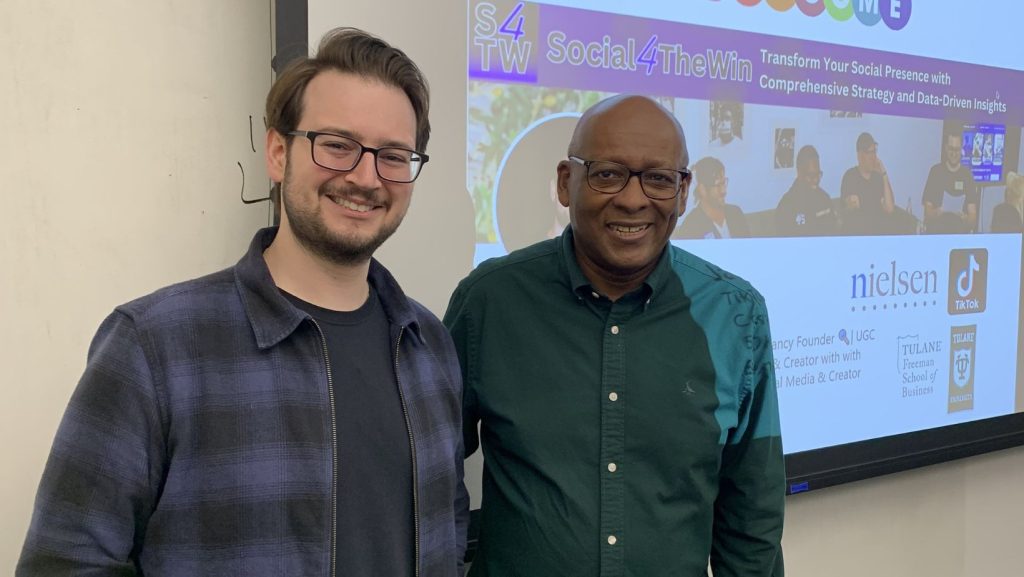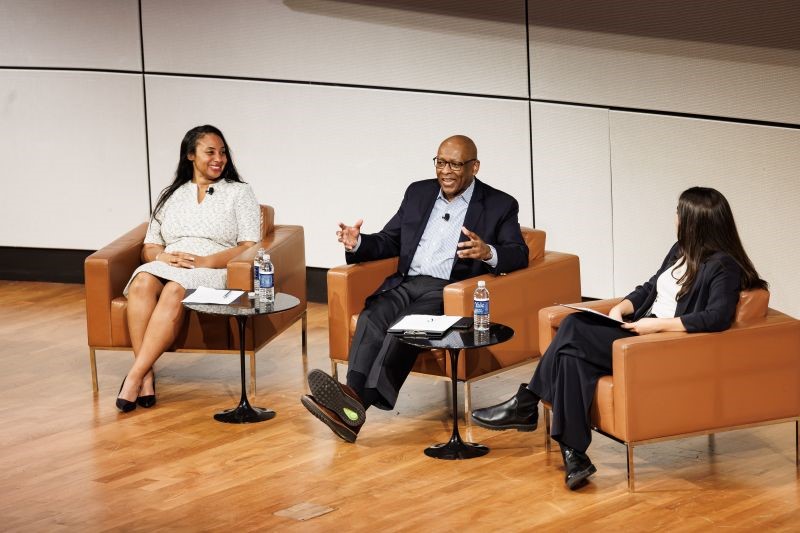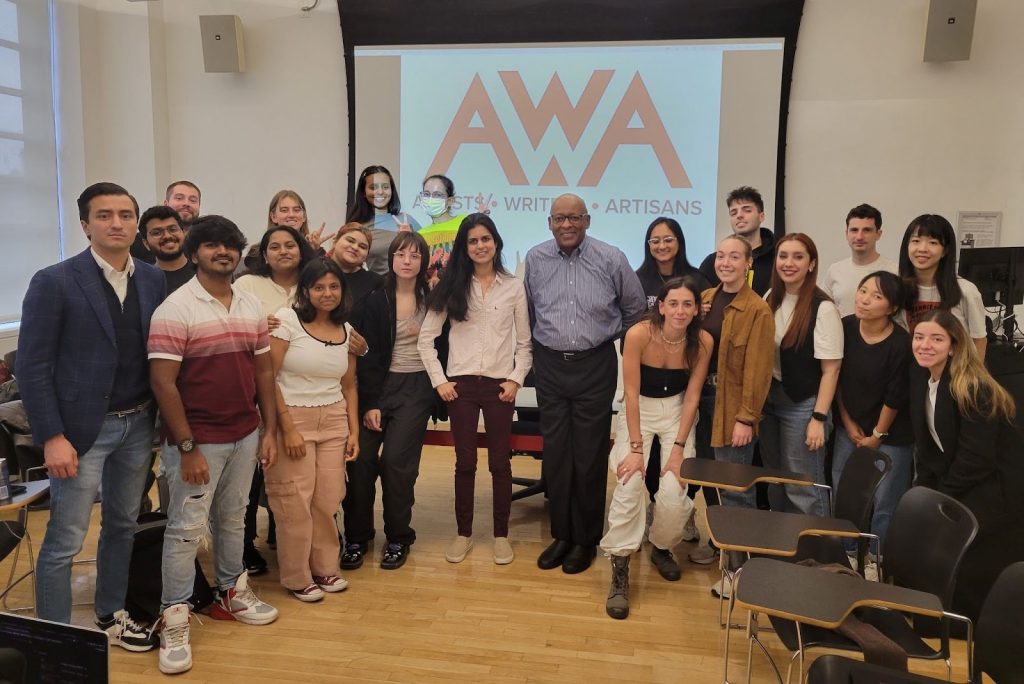
Championing Diversity in Media: A Conversation on Representation and Ethics
By Vismitha Yaji
This week for Profiles in Media we sat down with Mark Walton, Associate Professor of Practice in Media Management, a passionate advocate for underrepresented voices in media, to discuss his recent endeavors in moderating panels and creating a public face for diverse communities. With his experience at the Silicon Valley African Film Festival and a significant panel at Boston University focusing on advertising for black-owned media, Mark emphasized the crucial role media plays in shaping socio-cultural narratives.
In our conversation, he highlighted the challenges of balancing ethical responsibilities with economic realities in the industry, the importance of education in media ethics, and the evolving landscape of media distribution and consumption. Mark also shared his insights on the value of spontaneous conversations for professional growth, particularly in the wake of the pandemic. He encouraged a proactive approach to networking and the need to immerse oneself in diverse cultural experiences to foster creativity.

Media Ethics Guest speaker: Jacob Wallach, TikTok Brand Strategist
With your recent busy schedules and ventures of moderating and being involved in various events, would you please share any exciting projects or research you are currently working on?
I’ve been focusing my recent efforts on moderating panels and bringing visibility to underrepresented groups whose content deserves to be shared with the world. My goal is to develop strategies and best practices for amplifying these voices by participating in various public forums. Fortunately, my previous work has led to invitations from organizations I admire.
Just last week, I returned from the Silicon Valley African Film Festival, where film leaders and community members gathered to celebrate African cinema. The festival featured renowned film industry icons like Dr. John Kani and Souleymane Cissé, alongside Julie Dash, whom I had the honor to help facilitate her attendance. I was there to moderate a panel on distribution and to present the Cultural Icon Award, and we had meaningful discussions about the business side of filmmaking—addressing the serious, non-creative aspects that are crucial for giving filmmakers works exposure.
Additionally, about a month ago, I moderated a panel at Boston University focused on increasing advertising dollars for black-owned media companies. We explored how to get more financial support into the market to ensure these voices are not only heard but also are financially sustainable. Both experiences reflect my commitment to addressing the marketing and distribution challenges faced by underserved communities through public discourse.
I believe that by engaging in these conversations, we can tackle the heart of the issue surrounding the distribution and marketing of content from groups that are often overlooked. It’s about creating a platform for these narratives to thrive and advocating for better representation in the media.
What role do you feel like the media plays in shaping these socio cultural narratives, and how would you address this in your particular work?
Unfortunately, I think many people aren’t as studious as we’d like them to be. The average American consumer often consumes media that’s pre-packaged and formatted without taking the time to research deeper. For example, in my recent writing, I explored the landscape of cable and broadcast TV, as well as streaming services. Despite the 42 million Black Americans in the U.S., with 20% of that population coming from Africa or the Caribbean, these groups are rarely represented in anything beyond stereotypical roles.
This lack of representation skews our understanding of who is actually in this country. It also impacts how we view these communities, especially in the current political climate. To address this issue, I’ve been moderating panels and writing articles advocating for better representation of the diversity of the Black diaspora.
For our students, I developed a course focusing on minority-owned businesses, including Black, Hispanic/Latino and Asian companies, to highlight their contributions to the American fabric. This initiative aims to educate students on the variety of business settings where people of color thrive and to dispel the myths circulated in political discourse about their roles in society.

Donald H. Ogilvie Colloquium speaker at the Yale School of Management
How do you balance teaching the ethical responsibilities of media professionals with the practical business realities of media management?
I think it’s crucial to address the inseparability of ethics and economics in media, especially since I currently have my media ethics class followed by my media economics class. In today’s world, we must focus on both ethical considerations and economic agendas. If you don’t balance the two, you risk misaligning the role of the media. No outlet should prioritize profit over truth, even in entertainment.
It’s essential to consider how to balance messaging while being ethically responsible. Ideally, one should strive to engage with advertisers who align with your values. As someone on this side of the fence, I aim to influence my students to understand that building a business and maintaining ethics aren’t mutually exclusive. You can grow a business from the ground up while adhering to your ethical compass. I’m encouraged by younger generations who are less siloed and more informed, especially in our digital age. I always encourage my Media Management students to analyze the numbers—they reveal what a company prioritizes financially and what values they embody. Ultimately, it’s about understanding both the management style and the broader community impact of the companies they work with.
Can you share a recent trend in media studies/management that has caught your attention and how you’re incorporating it into your own work or teaching?
I’ve developed an eclectic teaching style over my two and a half decades of experience, focusing on keeping students engaged through varied approaches. My classes typically begin with foundational lectures, especially in my multicultural class, where we explore demographics of Black Americans, Hispanic/Latine Americans and Asian Americans, their income levels, buying patterns and educational backgrounds to set the stage for discussing their media consumption.
I incorporate case studies, though I wish there were more featuring people of color as protagonists, which I aim to address by writing new cases about influential media figures often overlooked in traditional curricula. Student participation is key; through interactive exercises they present case analyses and engage in discussions, fostering a dynamic learning environment.
I also invite guest speakers to connect students with industry professionals. For example, in my ethics class a few weeks ago, they heard from a TikTok strategist about navigating ethical challenges in the social media space.. My approach combines lectures, case studies, and industry insights, hopefully creating a dynamic interactive classroom experience.
To complement my role in the classroom, this past year I helped facilitate the creation of the newest Media Studies student-run affinity group – Show & Sell. A group of students who expressed an interest in the distribution and marketing aspects of film, TV, and digital media, organized themselves and attained official status from the University as a recognized student organization. I’m proud to be their faculty advisor and mentor them through the process of maintaining a sustainable group. They have successfully hosted two-panel discussions with media industry professionals and are planning another one for November 20th.
How do you suggest ensuring that the content creators are able to reach the right audience across different platforms, especially as digital channels continue to evolve?
Now that I’m teaching, I feel unchained, able to freely share my ideas and embrace a more independent mindset. Case in point, at a recent event, I noted that a number of filmmakers mentioned their desire to have their content on streaming platforms like Netflix, whose prime objective is to amass content and subscribers, not necessarily to nurture diverse voices or cultural narratives.
I’m encouraging creators to prioritize platforms that uplift diverse stories. Selling to major companies often means losing the opportunity for community reinvestment, so supporting media outlets that enrich cultural dialogues is crucial.
I’m currently working with a few Caribbean creators and their governments to develop better distribution strategies. I have collaborated with the Barbados Ministry of Culture and more recently with the Caribbean Tourism Organization to help island nations understand the impact of media on tourism and investment. I cite South Korea’s success with shows like Parasite and Squid Games as a model for how storytelling can reshape perceptions and boost business opportunities. I am now organizing Caribbean countries to showcase their work at next year’s Cannes Film Festival through a pavilion focused on Africa and the diaspora (Pavillon Afriques), emphasizing the importance of actively promoting themselves in the global content landscape.
How do you stay ahead of emerging trends in media consumption, and what distribution strategies do you recommend to meet the evolving demands of both consumers and content creators?
The proliferation of media outlets has led to a devaluation of revenue for content creators. Many believe that platforms like Netflix will pay them well, but the reality is that these companies, being in a position of strength, often offer minimum compensation, leading to diminishing returns for creators. While the cost of production has decreased, allowing more people to enter the industry, creators now face a fragmented landscape with multiple avenues for distribution—streaming services, theatrical releases, and digital sales. This complexity requires them to adopt a more strategic and assertive approach to monetization and distribution rather than relying on the notion that great work will find its audience.
Later this month, I will be moderating a panel at the Horowitz Cultural Insights Forum in Miami, on the future of streaming and its impact on multicultural audiences. The industry is at a crossroads and it is crucial for creators to think independently and develop alternative strategies that enable success regardless of the shifts among major players.
How can we better prepare future media professionals to engage with and represent multicultural communities in an increasingly diverse society?
The course I developed on multicultural media business was a serendipitous opportunity, but it has resonated deeply with students. Many express a desire to have studied these topics earlier, highlighting that discussions about multicultural communities are often treated as sidebar in their media education. Given that over 40% of the U.S. population is non-white, it’s essential for aspiring media professionals to be equipped to understand America’s diverse communities.
To further address this gap in the classroom, I have integrated elements from my multicultural media course into my other classes. For instance, I utilized a Harvard Business School case study on Telemundo’s competition with Univision in my media economics course. This approach not only conveys the principles of broadcasting and advertising but also raises awareness of the significant impact of the Hispanic/Latino community in the United States.

Media Economics Guest speaker: Diya Sagar, CFO of AWA Studios
As a professor and a professional with more than decades of experience, what would be your advice for aspiring media enthusiasts about finding their unique voice while navigating industry guidelines and expectations?
In this current job market, I suggest that students focus on three things: what they enjoy doing, what they do well and then what specific jobs encompass both. Start with what you’re passionate about and let anybody and everybody know what you want to do. . The pandemic really took away the spontaneity of casual conversation and reaching out to people you don’t know for advice. When I had my business I started something I called “New Business Day” where every Wednesday I would follow-up on a lead, research someone I wanted to meet or randomly select a business card from a pile and reach out to connect with someone I had met. It actually led to some solid opportunities.
And don’t forget to step out of your comfort zone! Traveling internationally and connecting with people from different backgrounds can really spark your creativity. Even just trying to speak another language or tasting local food can change your perspective. In my classes, I always tell students to connect with their diverse classmates—you can learn so much from each other. Embrace the awkwardness of new experiences; that’s where the real growth happens, and you might just discover what you really want to do or make a connection with someone who can help get you where you want to go.